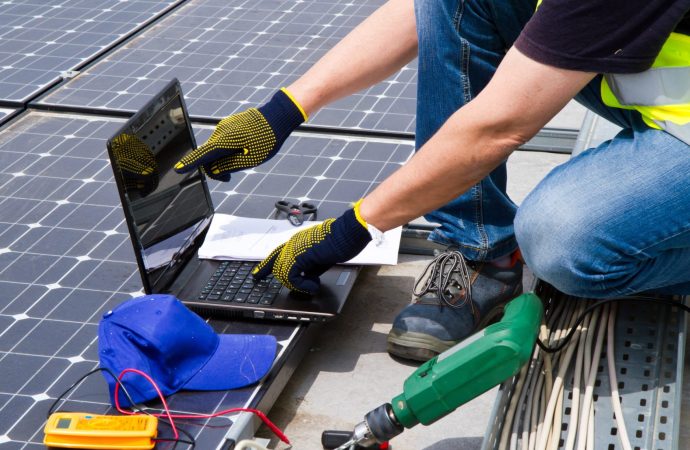Introduction Installing a solar panel system in Pakistan is becoming more popular as electricity prices rise and power cuts become frequent. Solar energy is clean, reliable, and can help reduce your electricity bill in the long run. If you’re thinking about switching to solar power for your home or business, this guide will help you
Introduction
Installing a solar panel system in Pakistan is becoming more popular as electricity prices rise and power cuts become frequent. Solar energy is clean, reliable, and can help reduce your electricity bill in the long run. If you’re thinking about switching to solar power for your home or business, this guide will help you understand each step of the installation process in simple terms.
Why Solar Makes Sense in Pakistan
Pakistan enjoys over 300 sunny days each year, making solar energy highly effective. Key benefits include:
- Lower Electricity Bills: Reduce or eliminate your monthly utility charges.
- Reliable Power: Say goodbye to loadshedding and blackouts.
- Environmental Impact: Cut carbon emissions and support a cleaner future.
- Energy Independence: Produce your own power and protect against rising rates.
Given frequent grid instability, solar is no longer a luxury but a necessity for many households and businesses.
Planning Your Solar Panel System
Before diving into hardware and wiring, careful planning is essential:
- Site Assessment: Check roof space, orientation, and shading.
- Load Calculation: Estimate daily electricity use in kilowatt‑hours (kWh).
- Budgeting: Determine how much you can invest and calculate payback periods.
- Permits & Net Metering: Understand local regulations with NEPRA and state DISCOs.
This upfront work ensures your solar system meets your energy needs and stays within budget.
How to Install a Solar Panel System in Pakistan: Step-by-Step Guide
Step 1: Assess Your Energy Needs
The first step is to know how much electricity you use every month. Check your electricity bill to find your average monthly units (kWh). This will help you decide what size of solar system you need. For example:
- A small home may need a 3kW system.
- A medium-sized home might need a 5kW system.
- Larger homes or offices may require 10kW or more.
Knowing your energy needs is very important because it determines the system size, cost, and number of panels.
Step 2: Site Inspection and Roof Evaluation
The next step is to check your rooftop or the area where you plan to install the solar panels. The ideal location should:
- Get sunlight for at least 5 to 6 hours a day.
- Be free of shade from trees or nearby buildings.
- Have a strong and flat surface (for rooftop systems).
In case your roof isn’t suitable, ground-mounted systems can also be used.
Step 3: Choose the Right Type of Solar Panels
There are mainly three types of solar panels available in Pakistan:
- Monocrystalline (high efficiency, higher cost)
- Polycrystalline (moderate efficiency, affordable)
- Bifacial (generate power from both sides)
Choose panels based on your budget, space, and energy needs. For better performance and longer life, many people also pair their solar systems with branded batteries like Osaka. If you’re planning to add batteries, it’s helpful to compare options based on performance and cost, such as checking the osaka battery price in pakistan today to plan your budget accordingly.
Step 4: Select the Right Inverter and Batteries
An inverter is the brain of your solar system. It converts the DC (direct current) electricity produced by the panels into AC (alternating current) electricity used in your home.
Types of inverters:
- On-grid: Connected to WAPDA; no battery.
- Off-grid: Works independently with batteries.
- Hybrid: Works with both grid and batteries.
If you face frequent power cuts, consider a hybrid system with batteries. Batteries store extra energy, which is useful during the night or load shedding.
Step 5: Get Quotations from Solar Installers
Now that you know what type of system you want, it’s time to contact professional solar installers in your city. Ask them for:
- System design based on your needs
- Pricing (with and without batteries)
- Warranty and after-sales service
- Brand options for panels, inverters, and batteries
Compare at least 2–3 companies before making your decision. Reliable installers will provide free surveys and guidance about net metering and maintenance.
Step 6: Installation Process
Once you finalize the installer, they will begin the installation, which usually takes 2–4 days. The steps include:
- Mounting structure installation
- Fixing the solar panels
- Wiring and inverter connection
- Battery setup (if included)
- System testing and activation
Always make sure the installation is done by certified technicians to avoid future issues.
Step 7: Net Metering Application (Optional but Recommended)
Net metering lets you send extra electricity back to the grid and get credit for it. This lowers your bill even more.
To apply for net metering in Pakistan, you’ll need:
- A three-phase meter
- Verified installer’s documents
- Approval from the local electricity company (e.g., LESCO, KE, etc.)
The approval may take a few weeks, but it’s worth it in the long term.
Step 8: Regular Maintenance
Solar systems require very little maintenance. However, you should:
- Clean the panels every 10–15 days
- Check battery water levels (for lead-acid types)
- Monitor system performance monthly
Some companies also offer free annual checkups, so make sure to ask during purchase.
Step 9: Understand the Cost and Payback Period
One of the most important things to consider before installing a solar panel system is the total cost and how long it will take to recover that cost. The price of solar systems in Pakistan depends on the system size, brand, and whether it includes batteries or not.
Here’s a basic price breakdown (as of 2025):
- 3kW system: PKR 450,000 – 550,000
- 5kW system: PKR 750,000 – 950,000
- 10kW system: PKR 1.4 million – 1.7 million
Adding branded batteries like Osaka will increase the cost, but it also improves backup during power outages. That’s why many buyers now compare the osaka battery price in Pakistan today before selecting a solar package.
The payback period for most systems in Pakistan ranges from 3 to 5 years, depending on:
- Electricity unit rates
- Whether net metering is applied
- Energy consumption patterns
- System maintenance
After this period, the electricity you generate is practically free. Plus, solar systems usually last 20–25 years, making them a smart investment.
Step 10: Battery and Charge Controller Integration (Off‑Grid/Hybrid)
For off‑grid or hybrid systems requiring storage:
- Install Charge Controller: Place it close to the battery bank.
- Battery Bank Setup: Connect batteries in series or parallel to match system voltage (12 V, 24 V, or 48 V).
- Battery Safety: Enclose batteries in a ventilated, fireproof box and use proper cable sizing for high currents.
- Inverter‑Charger: For hybrid systems, an inverter‑charger handles both solar power and grid or generator input seamlessly.
Test battery voltage and controller operation before commissioning.
Step 11: Permits, Inspections, and Net Metering
In Pakistan, grid‑tied solar systems require:
- Approval from DISCO: Submit application forms, electrical diagrams, and component specifications to your local Distribution Company.
- Inspection: A DISCO engineer will inspect the installation to ensure compliance.
- Net Metering Agreement: Sign a net‑metering contract—this allows you to export excess solar power to the grid and earn credits.
- Meter Installation: The DISCO installs a bidirectional meter.
Net metering rules vary by province; Punjab, Sindh, and KPK each have their own tariffs and fees.
Step 12: System Testing and Commissioning
Before going live:
- Initial Tests: Check open‑circuit voltage (Voc) and short‑circuit current (Isc) of each string.
- Inverter Startup: Follow the inverter manual to program grid parameters—voltage, frequency, and anti‑islanding settings.
- Full System Check: Monitor power output on a sunny day and compare to expected performance (using PVWatts or manufacturer data).
- Safety Inspection: Ensure all connections are tight, labels are in place, and enclosures are sealed.
A smooth commissioning guarantees optimal performance from day one.
Step 13: Maintenance and Troubleshooting
Maintenance keeps your system running efficiently:
- Regular Cleaning: Dust and bird droppings reduce panel output by up to 15%. Clean panels every 3–6 months with water and a soft brush.
- Visual Inspections: Check for loose clamps, cracked panels, or wiring corrosion.
- Performance Monitoring: Use inverter apps or third‑party monitoring systems to track daily output and spot dips.
- Battery Care: For off‑grid setups, check battery electrolyte levels and terminal tightness every month.
Prompt attention to issues prevents bigger repairs down the line and extends system life to 25+ years.
Final Thoughts
Installing a solar panel system in Pakistan is a smart and sustainable choice. It not only reduces your electricity costs but also increases the value of your property. Whether you’re in Karachi, Lahore, or a rural area, solar energy can provide reliable power for years to come.
If you want to get the most out of your system, make sure to choose quality products and compare market prices, such as checking the osaka battery price in pakistan today, before making your final decision.
Note: You can checkout all types on information on https://truegazette.com/






















